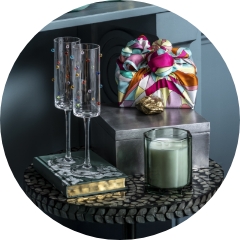Back to the Office, styled for success
When WFH was at its peak, many of us were guilty of commuting from bed to desk in our pyjamas, bathrobe or slippers and back again. But now that many of us are back to the office – and back to reality – how have our fashion choices evolved? For most of us, those days of holding video calls in our pyjamas are well and truly over…
To find out, TK Maxx polled over 2,000 UK office employees to uncover the latest work wardrobe habits.
- Office life is well and truly back. 54% of people aged 16-24 said they’ve spent more time in the office over the past year.
- Is formal the new normal? 45% of respondents (and 67% of young millennials) told us their work clothes have become ‘more formal’ over the past 12 months.
- ‘Hybrid’ can be a head-scratcher. 37% of people agreed that hybrid working has made their fashion choices ‘more confusing’, not knowing whether to reach for jeans and trainers or a blazer and heels when splitting time between home and the office.
- Suited and booted. 40% of people say they dress a certain way because they feel a pressure to look more polished or professional in the office.
- But many people are happy to shell out on their work wardrobe, with respondents willing to spend an average of £119.75 on a complete office outfit (excluding those who were ‘not sure’).
The great office comeback
Many employees have boomeranged from the home to the HQ, and some industries have seen a greater return to work – those in IT & telecoms (51%) and finance (49%) were the most likely to say their office days have increased.
But of course, WFH was never an option for some and employees in retail, catering and leisure were the most likely (69%) to say their workplace attendance has stayed the same.
Young people were the most likely to have made it back to their work desk. More than one in two (54%) people aged 16-24 said they’d spent more time in the office over the past year, compared to 14% of over 55s.
It’s fine to be formal
Now that we’re draped in office lanyards again, are we suddenly keen to wear suits and ties?
We found that men were more likely than women (52% versus 40%) to say their wardrobe has become more formal.
And age is no barrier to wearing traditional work clothes – young millennials aged 25-34 were the most likely (67%) to say their wardrobe has become more formal. Gen Z (16-24) were not far behind (62%).
But while many of us are smartening up, it all depends on who’s in the office. Almost four in ten (39%) people said they dress smarter if they’re seeing a client or external visitor, rising to 48% among 25–34-year-olds.
Hybrid habits
More than a quarter of workers (28%) in Great Britain are hybrid workers, according to ONS data from early 2025. Given our uneven work schedules, hasn’t this made our wardrobe decisions a little, well, confusing?
The answer: yay and nay. 37% of people agreed that hybrid working has made their fashion choices ‘more confusing’. This rose to 42% among 16-24 year-olds.
Many of us are taking our time to pair the right blazers, shirts and accessories (psst – see our women or men’s workwear).
- People are most likely (38%) to spend five to ten minutes planning their office outfit.
- On average, females spend slightly less time (11.03 minutes) planning their outfit than males (11.43 minutes).
- C-Level execs (13.02 minutes) and senior management (12.62 minutes) spend the most time planning their
outfits.
For some, there’s a pressure to meet expectations when it comes to looking ‘work wonderful’.
25-34 year-olds (53%) were most likely to feel the pressure to look polished, while 55+ year olds (24%) were the least likely. Meanwhile, males were slightly more likely (25%) to feel the pressure to look fashionable or on-trend than women (22%).
Comfort is king (and queen)
While many of us feel the pressure to look effortlessly on-trend and office chic, our work wardrobes aren’t so different from our everyday wear. What we value most when getting dressed for work comes down to comfort (47%), professional appearance (37%), and the weather (33%).
From the living room to the boardroom, we love to feel comfortable in the clothes we wear. We found that females are slightly more influenced by comfort than males – 48% versus 46%. In contrast, males were more concerned than females about professional appearance (38% versus 36%).
Our level of seniority also shapes our sartorial desires. C-Level execs were the most influenced by professional appearance (50%), but for entry level employees, 48% were most influenced by comfort.
Dresses for success
Despite the occasional pressure to dress ‘smart’, it seems that few of us are bitter about pulling on those brogues.
A large majority (72%) of people told us they’ve bought clothes that they wouldn’t wear outside of work. In fact, 40% have a work-only wardrobe.
And when asked how they feel about dressing for the office in 2025, respondents were most likely (28%) to say they “enjoy it” as a chance to express their style. This sentiment was highest (36%) among young millennials (25-34 years-old).
This corresponds with a recent Bupa survey which found that 45% of Gen Z respondents are thinking about getting a job with more social interaction.
What’s more, we’re also putting our money where our mouth is.
On average (excluding the ‘not sures’), we’d be willing to spend £119.75 on a head-to-toe office outfit. For males the figure was higher (£141) compared to females (£99), while those working in finance (£160.93) and legal (£130.09) were the sectors most likely to splurge.
How to navigate the new office normal
Who says we can’t dress for work in comfort and style? Here are just some of the ways you can become an absolute boss in the office dress code stakes.
- Blend your styles. Formal doesn’t have to mean boardroom stiff. Try pairing smart blazers with a casual open
collar shirt.
- Read the room. Every organisation is different, and your colleagues can provide some visual clues on where you sit on the smart-casual spectrum.
- Start smart, creep to casual. Day one of a new job? There’s nothing wrong with starting formal – from smart men’s sweaters to black dresses. Then once your feet are under the table, it’s time for the flip flops (or maybe not).
Office dress etiquette may be a revolving door but for a work style that’s truly YOU, upgrade your work wardrobe for so much less than you’d expect at TK.














